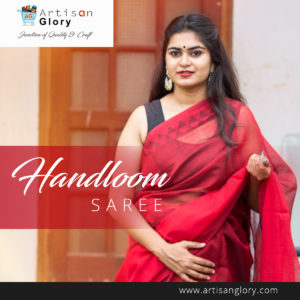
The Munga Handloom Silk Sarees from Assam
The Munga Handloom Silk Sarees from Assam
Introduction
As well known as its pleasant tea ranches is Assam’s Muga silk. The perfect texture, known for its outrageous toughness and characteristic yellowish-brilliant tint, was once saved distinctly for sovereignty. Indeed, it is regularly contrasted with being as costly as purchasing gold. Throughout the years, the silk has just figured out how to acquire prevalence, with the Muga silk presently turning into a pined for thing for wedding and customary wear.
Beginning and history
Sericulture is an old industry in Assam that doesn’t generally have a time span. Known to exist since the very beginning, the main files of Muga silk generation coming into the spotlight was during the Ahom administration (1228-1826).
It was during this period that Muga culture flourished and turned into a vital piece of the social and monetary existences of local people. Ahom lords were known to wear just Muga silk and the texture was supplied in the kingdom too displayed to guests of their court as one of the best nearby contributions.
Muga silk has been given the Geographical Indication (GI) status since 2007 and the logo for true creation has been enlisted with Assam Science Technology and Environment Council. The Central Silk Board of India has the expert to examine Muga silk items, confirm their realness and enable brokers to utilize the GI logo.
Weaving process
Muga silk, which is primarily created by the Garo people group of Assam, is gotten from the semi-tamed multivoltine silkworm, Antheraea assamensis. These silkworms feed on the leaves of Som and Soalu plants and the silk created from them is known for its shiny surface and strength.
Normally, a silk rancher expects access to in any event a section of land in the event that he needs to develop around 400 grams of Muga silk at a go.
Further, 1000 covers can produce around 125 grams of silk yet a solitary saree requires in any event 1000 grams of silk. The time taken to weave a solitary Muga silk saree is about two months, from raising the silkworm to getting the completed item. The real weaving procedure takes around multi week to 10 days to finish.
Exceptional highlights
The brilliant shading and sparkle of the texture is one of the most extraordinary highlights of Muga silk. Truth be told, the sparkle of the texture is said to improve after each wash making it an item that will last you a lifetime, and furthermore making it probably the costliest silk on the planet.
A Muga Mekhela Chador, the customary dress of Assamese ladies stays one of the most pined for style things for local people.
Hues
A brilliant yellow base shading is the principle selling the purpose of this silk. Extra hues are included by means of weaving and zari work to make the item increasingly alluring. Be that as it may, in the event that you need to put resources into a Muga silk saree, the splendid gold shading is an exemplary must-have.
Themes
Customary themes that are utilized on the texture incorporates Jappi (the run of the mill Assami topi), Miri Gos Butta (an example of smaller than usual tree themes) and kabutar (pigeons). These themes are constantly geometrical fit as a fiddle and have not changed throughout the years. Unadulterated jari work is likewise found on the texture, giving it an exceptionally illustrious, tasteful feel.
Assortments
Mekhela chadors, a two-piece saree and the conventional outfit of Assamese ladies, regularly worn during weddings, and the five-yard saree are the greatest assortments of this texture. You additionally get the silk in “reeha”, which is a bit of texture that is worn on exceptional events like pujas, weddings, and celebrations. You additionally observe the Muga silk utilized in making shawls and dress material.
Current best in class
Muga silk has the Geographical Indication status, which aides in guaranteeing bona fide items and controlling quality in the market. In the most recent year alone, India delivered 158 tons of Muga silk, out of which 136 tons was created in Assam. India’s completely yield that very year was 28,708 tons.
Muga silk stays a great thing that each lady wants to claim, anyway its conventional standpoint, and non-flexibility (it hasn’t generally advanced much past the customary Mekhela chadors), makes the interest a little specialty.
All things considered, the texture has a worldwide associate particularly in Japan where planners are utilizing it to make kimonos and other conventional Japanese dresses.
Value
Muga silk is probably the most elevated nature of silk and its capacity to hold the first brilliant gleam, makes the most advantageous. A unique bit of work can cost you anyplace between Rs.10,000 to Rs.1,50,000.
The most effective method to distinguish a Muga silk saree
The main strategy to distinguish a Muga silk from other common silk is by utilizing a particular sort of magnifying instrument. In any case, the severe quality check at the hour of generation and the GI status guarantees that you just grasp a unique item. An alert could be the expense – if it’s under Rs.10,000 or if the businessperson is happy to sell it at a markdown, you may purchase a phony item.
Care control
Cleaning is the most favored strategy for keeping up a Muga silk saree. Notwithstanding, on the off chance that you do need to wash the saree at home, abstain from utilizing cleanser during the initial three washes. A flush in virus water is all that could possibly be needed. It is fitting to store the saree independently in a plastic or saree sack.
Shop Now – www.artisanglory.com








Comments
Trackbacks & Pingbacks
[…] Also Read: The Munga Handloom Silk Sarees from Assam […]